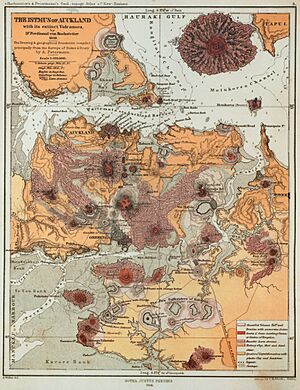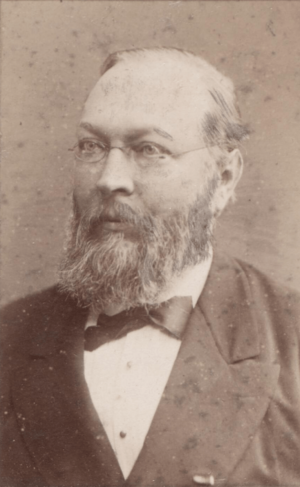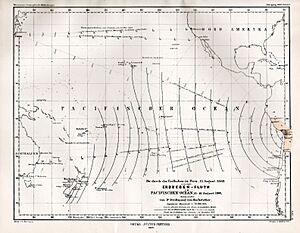Ferdinand von Hochstetter facts for kids

Ferdinand von Hochstetter (born April 30, 1829 – died July 18, 1884) was a famous German-Austrian geologist. Geologists study the Earth's rocks, landforms, and history. In 1857, he joined the Austrian Novara expedition. This was a big trip around the world. During the trip, he collected many natural items. He also created the very first geological map of New Zealand.
Contents
A Geologist's Journey
Ferdinand von Hochstetter was born in a town called Esslingen, in Germany. His father was a pastor who also loved to study plants and rocks. Ferdinand studied at the University of Tübingen. There, he became very interested in geology. He earned his doctor's degree and a special scholarship to travel.
In 1853, he joined the Imperial Geological Survey of Austria. This was a group that studied the geology of Austria. He worked in different parts of Bohemia and the Fichtel Hills. His excellent reports made him well-known. Because of his good work, he was chosen for the Novara expedition. This expedition traveled all around the world from 1857 to 1859. Ferdinand made many important observations during this journey.
The Novara ship arrived in New Zealand on December 22, 1858. Soon after, he met another German scientist, Julius von Haast. They became lifelong friends. A local scientist, Arthur Purchas, convinced Ferdinand to stay in New Zealand. He spent nine months there, exploring the land.
In 1859, the New Zealand government hired him. His job was to make the first geological survey of the islands. He carefully studied old Lake Rotomahana. He also looked at the famous Pink and White Terraces. His detailed notes are the only original records of where these terraces were. Researchers used his diary from 2016 to 2020. They used it to find the exact spots of the Pink, Black, and White Terraces.
After his time in New Zealand, he returned to Vienna. In 1860, he became a professor. He taught about mineralogy and geology. From 1874 to 1875, he was the head of the institute.
Studying Ocean Waves
Ferdinand von Hochstetter also studied a huge ocean wave, called a tsunami. This tsunami happened after an earthquake in Peru in 1868. The wave caused damage in many places across the Pacific Ocean. It even caused deaths on the Chatham Islands.
Von Hochstetter mapped how the tsunami traveled. This helped scientists understand how tsunamis move. His work also helped estimate how deep the Pacific Ocean was.
In 1872, he became a science teacher for the Crown Prince of Austria. Later, in 1876, he became the head of the Imperial Natural History Museum. In his later years, he explored parts of Turkey and eastern Russia. He wrote many papers about geology, ancient life (palaeontology), and minerals.
In 1869, he became a member of the American Philosophical Society. In 1884, the Emperor of Austria made him a knight. This was a special honor.
His detailed diaries were very helpful in 2011. Researchers used them to find the Pink and White Terraces. These beautiful terraces were buried by the 1886 eruption of Mount Tarawera.
Personal Life
Ferdinand was the son of Christian Ferdinand Friedrich Hochstetter. His father was a clergyman who also studied plants and minerals. In 1861, Ferdinand married Georgiana Bengough. She was the daughter of an English director of the Vienna gasworks. They had eight children together. We know a lot about his life from his letters. He wrote many letters to his friend and colleague, Julius von Haast. Ferdinand passed away at age 55 from problems related to diabetes.
Legacy
The Geoscience Society of New Zealand holds a yearly lecture. It is named in honor of Ferdinand von Hochstetter.
Animals Named After Him
Many animals are named after Ferdinand von Hochstetter. New Zealand's special Hochstetter's frog is one example. Its scientific name is Leiopelma hochstetteri. The Takahē, a large New Zealand bird, is also named after him. Its scientific name is Porphyrio hochstetteri. There is also a giant carnivorous land snail called Powelliphanta hochstetteri.
Places Named After Him
Several places are named after Hochstetter. Hochstetter Peak is in Antarctica. In New Zealand, there is Mount Hochstetter on the West Coast. There is also Lake Hochstetter. Near the Tasman Glacier, you can find the Hochstetter Dome and the Hochstetter Icefall.
Geological Discoveries
Ferdinand von Hochstetter named a type of rock called dunite. He named it in 1859 after Dun Mountain. This mountain is near Nelson, New Zealand.
See also
- European and American voyages of scientific exploration




